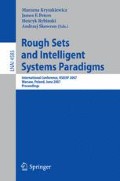Abstract
One of key problems in implementing a dynamic interface between human and agents is how to do semantic mapping from natural language questions to OWL. The paper views the task as a two-class classification problem. A pair of question variable and OWL element is a sample. Two classes of “Matched” and “Unmatched” explain two relations between the question variable and the OWL element in a given sample. Building appropriate semantic mapping is the same as classifying the sample to a “Matched” class by an effective machine learning method and a trained model. Two types of features of samples are selected. Syntactical features denote the syntactical structure of a given sample. Semantic features present multiple relations between the question variable and the OWL element in one sample. Preliminary experimental results show that the sum precision of the learning-based model is better than that of the constraints-based method.
Access this chapter
Tax calculation will be finalised at checkout
Purchases are for personal use only
Preview
Unable to display preview. Download preview PDF.
References
Androutsopoulos, I., Ritchie, G., Thanisch, P.: MASQUE/SQL-An Efficient and Portable Natural Language Query Interface for Relational Database. In: Proc. 6th International Conference on Industrial and Engineering Applications of Artificial Intelligence and Expert System, Edinburgh (1993)
Androutsopoulos, I., Ritchie, G., Thanisch, P.: Natural Language Interfaces to Databases - An Introduction. Journal of Natural Language Engineering 1(1), 29–81 (1995)
Bernstein, A., Kaufmann, E., Fuchs, N. et al.: Talking to the Semantic Web - a Controlled English Query Interface for Ontologies. AIS SIGSEMIS Bulletin 2(1), 42–47 (2005)
Cunningham, H.: Software Architecture for Language Engineering. Doctor of Philosophy, Department of Computer Science, University of Sheffield (June 2000)
Jurafsky, D., Martin, J.H.: Speech and Language Processing: An Introduction to Natural Language Processing. In: Computational Linguistics, and Speech Recognition, Prentice-Hall, Englewood Cliffs (2000)
Fellbaum, C. (ed.): WordNet An Electronic Lexical Database. MIT Press, Cambridge (1998)
Gao, M., Liu, J., Zhong, N., Chen, F.: A Constraints-based Semantic Mapping Method from Natural Language Questions to OWL. In: CIDM’07. Proc. IEEE Symposium on Computational Intelligence and Data Mining, Honolulu, Hawaii, April 1-5, 2007 (in press)
Horrocks, I., Patel-Schneider, P., Harmelen, F.: From SHIQ and RDF to OWL: the Making of a Web Ontology language. Journal of Web Semantics 1(1), 7–26 (2003)
Lopez, V., Pasin, M., Motta, E.: AquaLog: An Ontology-Portable Question-Answering System for the Semantic Web. In: Gómez-Pérez, A., Euzenat, J. (eds.) ESWC 2005. LNCS, vol. 3532, pp. 546–562. Springer, Heidelberg (2005)
Popescu, A., Armanasu, A., Etzioni, O. et al.: Modern Natural Language Interfaces to Databases: Composing Statistical Parsing with Semantic Tractability. In: Proc. 20th International Conference on Computational Linguistics, Geneva (August 2004)
Popescu, A., Etzioni, O., Kautz, H.: Towards a Theory of Natural Language Interfaces to Databases. In: Proc. 8th International Conference on Intelligent User Interfaces, Miami, Florida (2003)
Paggio, P., Hansen, D.: Ontology-based Question Analysis in a Multilingual Environment: The MOSES Case Study. In: Proc. OntoLex2004: Ontologies and Lexical Resources in Distributed Environments (May 2004)
Tang, L., Mooney, R.: Using Multiple Clause Constructors in Inductive Logic Programming for Semantic Parsing. In: Flach, P.A., De Raedt, L. (eds.) ECML 2001. LNCS (LNAI), vol. 2167, pp. 466–477. Springer, Heidelberg (2001)
Witten, I., Frank, E.: WEKA Machine Learning Algorithms in Jav. In: Data Mining: Practical Machine Learning Tools and Techniques with Java Implementations, Morgan Kaufmann Publishers, San Francisco (2000)
Author information
Authors and Affiliations
Editor information
Rights and permissions
Copyright information
© 2007 Springer-Verlag Berlin Heidelberg
About this paper
Cite this paper
Gao, M., Liu, J., Zhong, N., Liu, C., Chen, F. (2007). A Learning-Based Model for Semantic Mapping from Natural Language Questions to OWL. In: Kryszkiewicz, M., Peters, J.F., Rybinski, H., Skowron, A. (eds) Rough Sets and Intelligent Systems Paradigms. RSEISP 2007. Lecture Notes in Computer Science(), vol 4585. Springer, Berlin, Heidelberg. https://doi.org/10.1007/978-3-540-73451-2_84
Download citation
DOI: https://doi.org/10.1007/978-3-540-73451-2_84
Publisher Name: Springer, Berlin, Heidelberg
Print ISBN: 978-3-540-73450-5
Online ISBN: 978-3-540-73451-2
eBook Packages: Computer ScienceComputer Science (R0)

